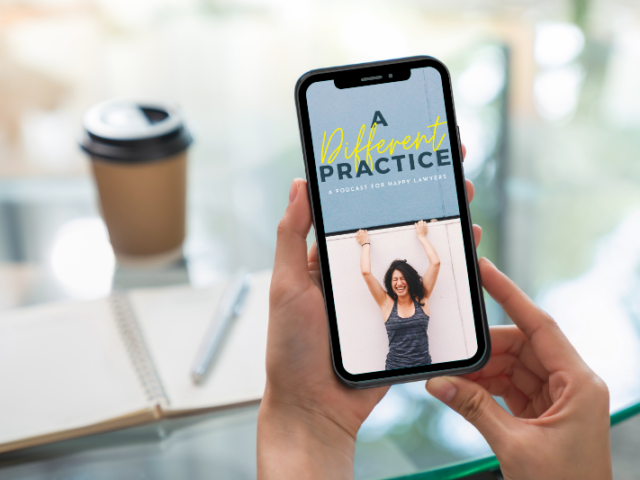By guest contributor Ryann Peyton, Director, Colorado Attorney Mentoring Program
Becoming a lawyer changes you. At a physiological level, research shows that simply preparing for the LSAT changes your brain structure[1] and the methodology of legal education changes the way our brains process fear and anxiety.[2] At a psychological level, accepting the immense responsibility of solving the problems of others and protecting the rule of law means lawyers must embody a new self as they enter the profession. This “professional” self or identity will ultimately serve as the cornerstone of their professional values and behavior, their ethical decision-making, and their well-being as lawyers.
Professional identity can mean many different things to different people. For some, it incorporates virtuous character. For others, it promotes civil actions and behaviors. For many, it is a combination of character and behavior. However you define it, at its core professional identity is vital to improving public perception of the legal profession, creating and maintaining lawyer well-being, and generating professionals whose personal values intersect with and guide their professional behavior.
So, what do you do?
This a question heard hundreds of times throughout the course of any typical networking event. The usual responses include: “I’m a lawyer.” “I’m a bankruptcy lawyer.” “I’m a partner at {insert big law firm}.” “I’m a solo family law attorney.” “I’m a district court judge.” “I’m in-house at {insert corporation}.”
These responses may seem varied, but they are really the same iteration of a very simplistic professional identity: a lawyer, who practices a certain type of law, in some type of setting. While one’s professional identity is of course much broader than a cocktail party sound bite, the repeated narrow description of “I’m a lawyer” in most social contexts can cause lawyers to eventually lose sight of their broader skills, values, ambitions, and identities.
To combat this “unconscious” narrowing of identity, lawyers should instead consciously focus on locating and developing a broader professional identity among the other aspects and roles of their professional and personal lives.
As lawyers, we are a homogenous bunch embodying the same basic skills and talents. These are all very real “performance requirements” that every lawyer needs to make it past the threshold of earning a JD or a license to practice law. While these skills may open up the door to practicing law, they may not actually predict success in the profession and, as a result, shouldn’t be the sole foundation of a lawyer’s professional identity.
Yet all too often, a lawyer’s professional identity embodies only these core “performance indicators” of lawyering. Although performance requirements are not what actually define each of us as professionals, it is these attributes that often shape our identities and unnecessarily limit our perception of our professional strengths.
Professional identity can move a lawyer away from the self-limiting and universal identifying traits of all lawyers and toward those unique and expansive traits that make the lawyer successful as an individual professional. Consider the following steps to uncovering your professional identity.
Step 1: Defining Professional Success
Describe what professional success looks like for you a month from today, a year from today, and 10 years from today. Consider whether your definition of professional success is truly your own, or a regurgitation of a vision of success that has been conveyed to you by others. Next, consider how many qualities of your definition of success are focused on extrinsic rewards and client outcomes versus intrinsic rewards.
Research has shown that the lack of attention paid toward intrinsic definitions of success and the inability for lawyers to accurately define professional success for themselves are some of the reasons for substance abuse, poor mental health, and professionalism issues among new and young lawyers.
As a result, it is critical for lawyers to create a realistic and meaningful definition of professional success for themselves – one which includes a balance of intrinsic rewards, extrinsic rewards, and positive client outcomes – that will serve as a foundation for the lawyer to develop a significant and achievable professional identity.
Step 2: Identifying Your Indicators of Success
Once a lawyer has created a personal definition of professional success, the next step is to identify the unique indicators of success that the lawyer brings to their practice. Your goal is to “think outside the box” and look past the basic traits all lawyers embody to see the personal characteristics that have helped you to find success in other areas of your personal and professional life.
Start by posing questions to yourself such as:
- What is a time when I felt like giving up? How did I persist?
- Thinking back on your college and graduate school experience. What classes did I absolutely love? What made them so enjoyable to me? How did I find success in those classes?
- What do I do on Saturdays? Why do I choose these activities? How am I successful at these activities?
- How do I relate to people? What makes me feel good about a social interaction with another person?
- How do I prepare for competition of any kind? Why do I prepare that way?
- What do I do only for myself? Why do I do those things for myself?
- What do I do only for other people? Why do I only do these things for others? What do others see as my strengths?
Using the answers to these types of questions, you start to become aware of the traits and characteristics that are unique to you and to the strengths and successes of your life. These indicators of success generally will contain two important features. First, these indicators will be substantive and transcend the practice of law. You will see these characteristics at play in almost every area of your life, both personal and professional. Second, these indicators will be innate to you. You will find that you do not need to improve, train, or force yourself to embody these characteristics or skills.
Indicators of success might include skills such as resiliency, relationship building, storytelling, or nimbleness. These personal indicators of success are the most likely skills to help you achieve your definition of professional success and will serve as a critical component to your professional identity as you face career challenges, adversity, and opportunity.
Step 3: Taking the 30,000-foot Point of View
The final step in developing a professional identity is to take a “30,000 ft” look toward one’s professional life. We are lawyers of course. But not all of us will be lawyers for the entirety of our careers, nor will we be perfect lawyers every day of our practice.
If your professional identity is narrowly defined as simply “lawyer,” it begs the question: What happens if you no longer want to be a lawyer? Similarly, what happens if you have a terrible day as a lawyer or experience a huge professional failure as a lawyer? Will a narrow professional identity allow you to overcome such setbacks?
A broad professional identity is necessary to provide lawyers with the agility to experience broad professional success and overcome broad professional challenges. Everyone will have a bad day or two as a lawyer. Everyone will make a mistake, lose a case, lose a client, or face adversity in practice. The strength of one’s professional identity will determine which lawyers go on to thrive in practice and which lawyers succumb to the obstacle.
To that end, lawyers should develop a professional identity that encompasses the entirety of who they are, including where they have come from professionally and where they are going professionally. Utilizing their personal definition of professional success and their personal indicators of success, lawyers can embody a professional identity that is holistic, comprehensive, and portable.
If you threw away everyone else’s expectations of you and just focused on what you want, what would success look like? How can you measure it? How does your professional identity align with that vision?
[1] Sanders, “Intense prep for law school admission test alters brain structure,” Berkley News (August 12, 2012)
[2] Patthoff, Abigail A. (2015) “This Is Your Brain on Law School: The Impact of Fear-Based Narratives on Law Students,” Utah Law Review: Vol. 2015 : No. 2 , Article 3.
Interested in being a guest contributor? Contact us!





